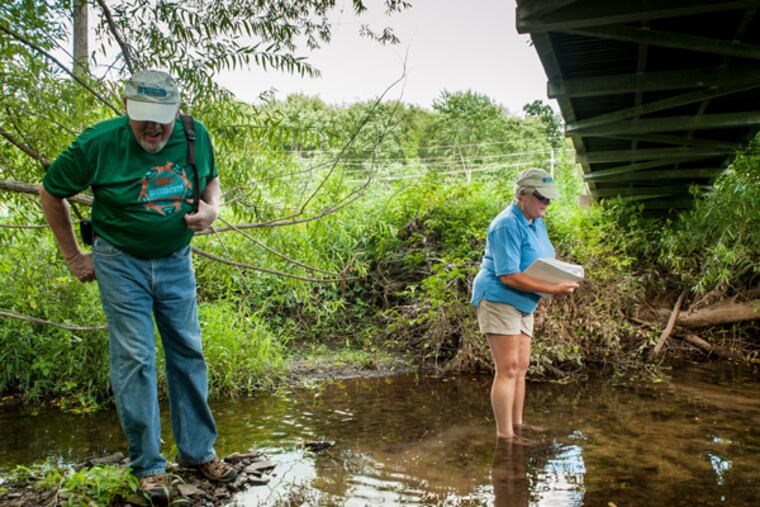Volunteers monitor water quality in Wissahickon watershed
"Days since last rainfall?" "Well, yesterday we got a little bit." "Water clarity?" "Looks pretty clear to me." "All righty. Stream bed color?"

"Days since last rainfall?"
"Well, yesterday we got a little bit."
"Water clarity?"
"Looks pretty clear to me."
"All righty. Stream bed color?"
"Brown," Doug McClure pauses, staring at the mud, "with green highlights."
"Odor?"
Wendy McClure doesn't wait for her husband's answer. She spreads her arms wide and raises her nose to the sky: "Doesn't smell like much of anything. Just a creek."
The North Wales couple were on their first official field survey Wednesday as "Creek Watchers" - a group of 60 amateur scientists collecting water-quality data for the Wissahickon Valley Watershed Association.
The association has its own scientists survey the creek - but only once a season, and only at 13 sites along the 64-mile watershed.
Having more eyes on the creek more often and in more places will make the data more detailed and accurate, said Stephanie Figary, the association's water-quality program director. And because the Wissahickon feeds into the Schuylkill, which feeds into the Delaware and on to the Atlantic, keeping these tributaries clean is important for the whole region.
Wendy McClure, a 58-year-old insurance analyst, and her husband, a 63-year-old truck driver, are assigned to a one-mile stretch of Wissahickon Creek along the Green Ribbon Trail in North Wales - a route they already walk at least once a week as trail stewards.
Although they'd been through training and were equipped with a binder and checklists, the amateur scientists found some things have to be learned by experience.
"Water flow - slow, moderate, swift, or combination?" Wendy McClure asks.
"Certainly slow if you look this direction. But this way, behind us, it's moderate," Doug McClure says, looking up at the professional to clarify. "Steph?"
"I'd go with slow," Figary says, looking down from the bridge.
After finishing at their first site, the McClures follow the creek south. They pass a clearing under Peco power lines recently converted into a meadow of native plants. They turn into a narrow tunnel carved out of young forest, and cross a tiny wooden bridge over a stream.
"Oh, you guys have a condition here," Figary says, stepping aside to let her proteges investigate.
Wendy McClure steps into the gully, examining an area where the water turns from clear to cloudy. She sees some clay; her husband sees some erosion; neither is sure what's causing the condition.
"So, we should just report some cloudiness in a tributary?" Doug McClure asks.
"Yeah," says Figary. "It might be something as simple as what it seems to be, which is low groundwater coming in from the rain. Or it could be something a little bit more serious," such as pollution from a construction site.
Such problems are usually quickly remedied, once they are reported, Figary says.
Temple University is working on a mobile app that will allow creek watchers to upload photos directly from the trail. That way, Figary and her colleagues can see the exact time, location, and situation to determine whether it merits further investigation.
For the McClures - who met three decades ago through their shared love of folksinging - the program is a way to protect what's left of the natural areas they played in as children, and to address some of their curiosities.
"As a casual observer, I didn't know a bad bubble from a good bubble," Wendy McClure says. "So I assumed all the bubbles were bad bubbles."
"Those bubbles," Doug McClure says, pointing to a string of brown ones, "I don't think they're bad bubbles."
Figary agrees.
610-313-8117 @JS_Parks